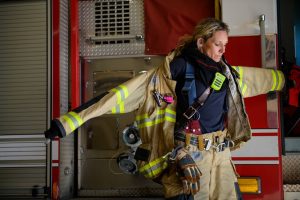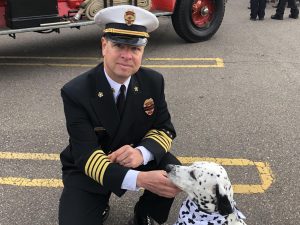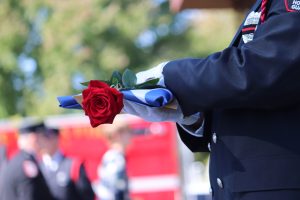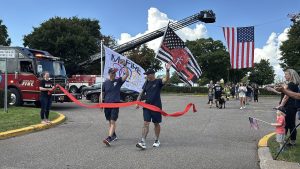Contributed by Dr. Nick Blonien, Occupational & Environmental Medicine
Poor sleep quality is a public health epidemic, and a problem estimated to burden nearly half of American adults. Decreased physical and cognitive performance, adverse health outcomes, decreased safety and lost productivity are some of the consequences seen in individuals who are underslept. And as we know all too well, the fire service is disproportionately impacted.
Traumatic experiences and hazardous exposures from firefighting contribute independently to increased risk of cardiovascular disease, emotional trauma and cancer. Quality sleep is a necessary component of firefighter resilience against these inherent threats. Unfortunately, shift work and nighttime disruptions prevent most firefighters, both career and non-career, from getting adequate sleep on a consistent basis. Such chronic sleep deprivation is likely to accelerate the development of illnesses that are already all too prevalent in the fire service.
In honor of Sleep Awareness Week, we’re sharing how crucial sleep is to your health and well-being, and steps you can take to promote better sleep.
Consistent poor sleep could be as harmful as the carcinogens you’re exposed to on the scene
Since 2019, the International Agency for Research on Cancer (IARC) has recognized night shift work as a group 2A carcinogen, meaning probably carcinogenic. Sleep disorders are also widely underdiagnosed across the fire service, and lead to 2-3 times higher odds of motor vehicle crash, work injury, diabetes, heart disease and mental illness.
In adults, at least 7 hours of quality sleep per night is deemed sufficient, but getting quality sleep in the fire service can be difficult. Anticipation of a call at night prevents restful sleep. Then a call comes in, and the sympathetic “fight-or-flight” response is activated. This sharpens focus and primes the body for action, but makes it incredibly difficult to fall back asleep once the run is complete. Plus, firehouses often have shared sleeping quarters, which limits the ability to personalize the sleep environment when time for sleep is available. At home, firefighters tend to prioritize time with family and other personal obligations over resolving “sleep debt” accrued from a busy night on duty.
The power of a good night’s sleep
Sleep is the most restorative and rejuvenating element of human life. During sleep, the body clears waste products of metabolism and cellular function, and builds neural networks in the brain that are responsible for learning and memory. Sleep replenishes the immune system, balances hormones and repairs the body so that it is primed for work and activity upon waking the following morning. There may not be a single biological function that doesn’t benefit from a good night’s sleep. Sleep quality is optimized when:
- Circadian rhythms – the 24-hour cycles that are part of the body’s internal clock, running in the background to carry out essential functions and processes like the sleep-wake cycle – are synchronized with light/darkness and other rhythmic cues.
- Homeostatic sleep drive – or tiredness – is high.
- Environmental conditions are favorable.
It’s difficult for firefighters to get routine quality sleep on top of increased risk for adverse health outcomes due to work in extreme environments. So, here are five simple ways to improve your sleep as a firefighter:
- Build a sleep sanctuary: The ideal sleep environment is cool, dark and quiet. Aim to set the temperature somewhere between 60-67° Avoiding screen use for two hours before bed is incredibly important, as the light emitted from electronic screens has a powerful impact on the body’s internal clock. Fans and other “white noise” may be helpful in creating a restful environment in an otherwise noisy firehouse or family home. Consider using light bulbs with red or dimmer light in sleeping quarters that are less stimulating to the eyes.
- Develop a bedtime routine: The brain needs to associate the bed with sleep only. Common techniques to help calm the body and recruit the parasympathetic “rest and digest” system include warm showers, gentle stretching, meditation and structured breathing. Consider a pre-bed routine that starts with taking a hot shower, followed by some reading under dim light on a non-electronic source, then 5-10 minutes of “cyclic sighing” in bed (4-second deep nasal inhale, 8-second slow oral exhale). These behaviors can calm the nervous system and set the stage for sleep.
- Nap strategically: Napping can improve daytime alertness and help resolve sleep debt, but it has to be done properly. Napping at the wrong time of day or for too long can compromise nighttime sleep quality. Naps for less than 30 minutes in the early afternoon are best, when the body’s circadian rhythm yields a natural dip in arousal. But only nap if needed, because oversleeping is also harmful to overall health.
- Live an active and healthy life: Daily exercise leads to the increased accumulation of adenosine, the primary molecule responsible for tiredness. Exercise will also help with weight loss, which can prevent development of sleep disorders like obstructive sleep apnea (OSA). Limit caffeine intake to the morning (less than 400 mg daily is ideal), and aim for minimal alcohol intake as well. A drink is less disruptive to sleep if had earlier in the day versus evening. Meal timing can also affect the body’s internal clock, so avoiding eating for the first 1-2 hours after waking and 2-3 hours before bed can be helpful.
- Promote a pro-sleep culture: The machismo “I’ll sleep when I’m dead” mentality needs to end. Address fatigue and sleep status often (perhaps daily), discuss it with other firefighters and make sleep a priority off duty.
It will always be challenging for career and volunteer firefighters to get sufficient sleep on a routine basis. But with a culture that prioritizes quality sleep and these techniques, firefighters can minimize the effects of insufficient sleep on performance and overall health, keeping them healthier for their families, colleagues and the public they proudly serve.
Put your department on a path to more ZZZs
We’re excited to announce we’ll be offering a new MnFIRE training session on the topic of sleep. If you’re interested in hosting a sleep training for your department soon, register here.








